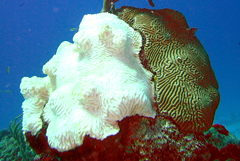|
|
The purpose of these modules is to introduce users to satellite-based tools that served the U.S. and international coral reef communities for more than 20 years, and were heavily used to pinpoint and monitor areas around the world where corals were at risk for bleaching. This tutorial focuses on NOAA Coral Reef Watch's heritage suite of 50km-resolution satellite coral bleaching heat stress monitoring products (retired in April 2020). We plan to update the tutorial in the near future to focus on the next-generation operational 5km-resolution satellite coral bleaching heat stress monitoring products (derived from a blend of geostationary and polar-orbiting environmental satellite data). The 5km satellite products are now the core near real-time decision support products Coral Reef Watch offers for coral reef management. The Coral Reef Watch (CRW) program, part of the U.S. National Oceanic and Atmospheric Administration (NOAA), assesses bleaching risk using satellite, modeled, and in situ environmental data. Since this tutorial focuses only on satellite monitoring of coral bleaching, we first provide background on satellite remote sensing. We then introduce some of the main tools (now retired) that CRW produced from NOAA's 50km satellite data, including twice-weekly global Sea Surface Temperature (SST), SST Anomaly, Coral Bleaching HotSpot, and Degree Heating Week (DHW) products. We also introduce briefly the 50km Virtual Stations product and associated Satellite Bleaching Alert email system. (Please note that the Satellite Bleaching Alert email system was upgraded in October 2016 to provide 5km satellite observational data. Therefore, the email system based on the 50km satellite data is no longer in use and was retired.) The aim of this tutorial is to teach you about NOAA CRW's heritage twice-weekly global 50km satellite-based products (retired on April 30, 2020). You will gain the skills needed to access and use prior satellite information about where coral bleaching was happening around the world. We have tried to make this tutorial instructive for the public, especially students and teachers, who want to learn more about coral reefs and satellite remote sensing technology. The lessons are tied to the U.S. National Science Education standards for use in the classroom. The tutorial is content rich and presented in easy-to-understand language. It is made up of 11 "chapters" (plus Reference and Resource pages) that can be read in sequence by clicking on the arrows at the top or bottom of each chapter page. The tutorial includes many illustrative and interactive graphics to enhance the text.
|
|
||||||||||||||||
|
|
||||||||||||||||||
|
IMPORTANT USER ALERT (2 July 2024): This past weekend, a storage server at NOAA's Center for Satellite Applications and Research, which delivers the NOAA Coral Reef Watch data, suffered a hardware failure. The issue is being addressed, and we hope to have the NOAA Coral Reef Watch data back up and running as soon as possible. (1) The most recent data will be made available first; historical data may take time to be restored. (2) If you need specific data that are not yet available, please contact us at coralreefwatch@noaa.gov. (3) If you use code to pull data, please revise your code to use “…/socd/…” in lieu of “…/sod/…” in all relevant web addresses for all future needs. We apologize for any inconvenience this may cause. |
